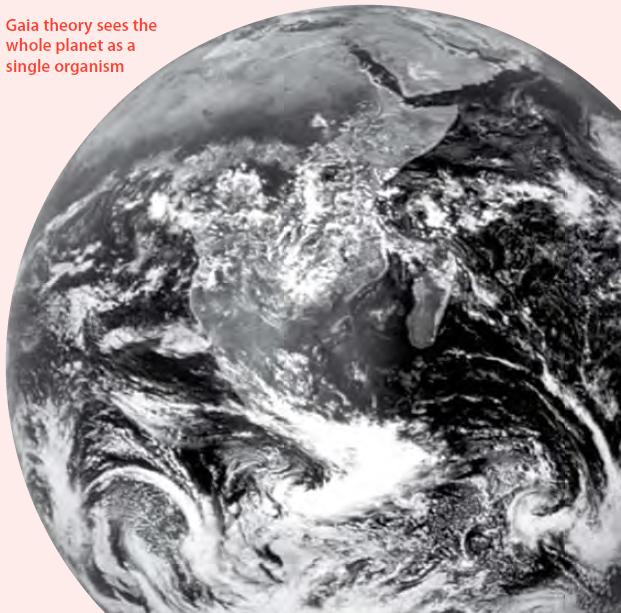Gaia
Since the 1970s a group of scientists centred on James Lovelock, a British chemist specializing in changes in the atmosphere, have pushed the Gaia theory, whose message is that the Earth, far from being a jumble of interacting components, is a self-regulating system that might be regarded as a single
organism.
Of course, Gaia would be completely unlike all the other living creatures we know. They reproduce and live among other similar creatures, whereas Gaia is a single planetary-scale being.
The theory is named after the Greek Earth Goddess Gaia or Gaea. It may sound counter-intuitive, but it is 'real' science in that it generates predictions that can be tested. An example is Lovelock's prediction that the rate at which rocks are eroded would speed up by a factor of several hundred in an environment where life is present. Lovelock predicted this to explain the very low concentration of carbon dioxide in the Earth's atmosphere compared to other similar planets. It was later shown to be correct.
Lovelock got the idea in the 1960s when he compared the Earth's atmosphere to that of Mars. He pointed out that the Martian atmosphere was almost entirely inert and consisted mainly of carbon dioxide and nitrogen. By contrast, the Earth's atmosphere contains both oxygen and methane, even though these two react together, because living organisms produce them continuously. This means that you can detect whether a planet like the Earth has life by measuring its atmosphere, avoiding the need for expensive space probes. But it also means that the atmosphere is a complex system created by life.
As an example of how it might regulate itself. Lovelock and his collaborators, notably US biologist Lynn Margulis, point to temperature, one of the most vital aspects of Earth as a home for life. One of the main influences on the Earth's temperature is how cloudy it is. Clouds are white and if you have more of them, the Earth will reflect more solar energy back into space, upping its albedo. Lovelock pointed out that a chemical emitted by algae called dimethyl sulphide encourages clouds to form, by creating aerosols of small particles on which water vapour can condense. The hotter things get, the more the algae thrive and the more dimethyl sulphide is created. This means more clouds, and eventually a cooler Earth. But if the Earth cools, there are fewer algae, the clouds dwindle and the temperature goes back up. So the whole system is self-adjusting to keep the temperature level.
You could argue that there is no intention in any of this. It just happens. But then, primitive mammals never intended to evolve into you and me. Over time. Lovelock argues, it is in the interest of life on Earth to develop systems that keep things comparatively stable. Even ice ages have a role in Gaia, and stop and start when the Earth gets too hot or cold.
One theory is that this planetary control system has developed over time to keep things stable in response to a gradual increase in the Sun's energy output over billions of years.
But it is not Lovelock's message that we can do anything we like with the Earth and wait for Gaia to put it right again. The planetary management system he describes works to cope with change on a geological timescale. It risks being overwhelmed if we push vast amounts of greenhouse gases into the atmosphere, or remove a large part of the tropical jungles, much as it takes a long time to recover from a major volcanic outbreak or the sort of meteorite strike credited with the mass extinction that killed off the dinosaurs.
Some think that Gaia will cope with this crisis by getting rid of us, or drastically reducing our numbers. This is the fate with which Lovelock threatens us in his latest book. The Revenge Of Gaia. But even Lovelock accepts that there may still be time to avoid this crisis by limiting population growth, overuse of the land and the oceans, and our consumption of fossil fuels.
